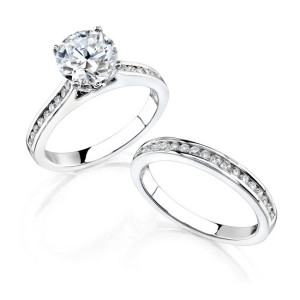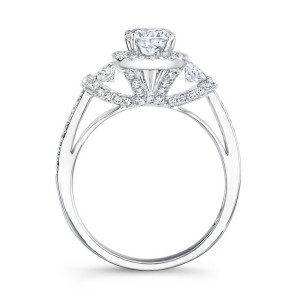Choose a Setting That’s Right For Your Ring
We’ve gone over the Four C’s and discussed shape, you’ve selected your dream diamond, but now you have to figure out where and how it will be set. There are many different setting styles, each offering different advantages and aesthetic qualities. Remember, if you’re opting for something other than a prong-set solitaire the combinations can be endless. To get you started here’s quick glossary.

Prong: The most popular type of engagement ring settings is by far the prong setting. It consists of 3 to six claws which hold on firmly to the crown and girdle of your diamond. The advantage of such a setting, with such thin wires, is that it allows for the most light to enter the diamond amplifying its sparkle. You will want to consider however whether you want a low or high prong set. Higher will add more emphasis to your center diamond while low is more convenient for day to day activities.
Channel: The channel setting holds a row of diamonds between two channels of metal. The diamonds do not touch one another and have every edge protected against wear and tear. This is a popular choice for wedding bands and can add a striking and modern touch to the shank of an engagement ring.

Bezel: A bezel set diamond is a metal rim that usually surrounds a diamond completely. While it is one of the most secure settings, protecting the girdle of your diamond from niches and chips, it doesn’t allow as much light to enter and be reflected by the diamond. Not the ideal setting for a center stone, but can create a lovely affect with detail stones or side stones.
Pave: Tiny diamonds are set closely together and have the appearance of a paved street. The diamonds are set within tiny holes and held in place by beads at the level of the surface of the ring. It is a challenging look to accomplish because of the patience necessary to set so numerous and such small stones but offers a dazzling blanket sparkle affect.
Flush: The diamond is set within a hole in the band of the ring, the metal is then hammered around the perimeter to keep it gripped securely and create a completely smooth surface. Elegant for men’s wedding bands.

Tension: A tension setting creates the incredible illusion that the diamond is floating. The diamond is held on two sides by pressure. While this is not the most secure setting and doesn’t offer much in the way of protection for the diamond if your engagement ring will become a special occasion piece it offers a wow factor.